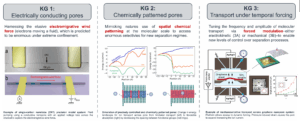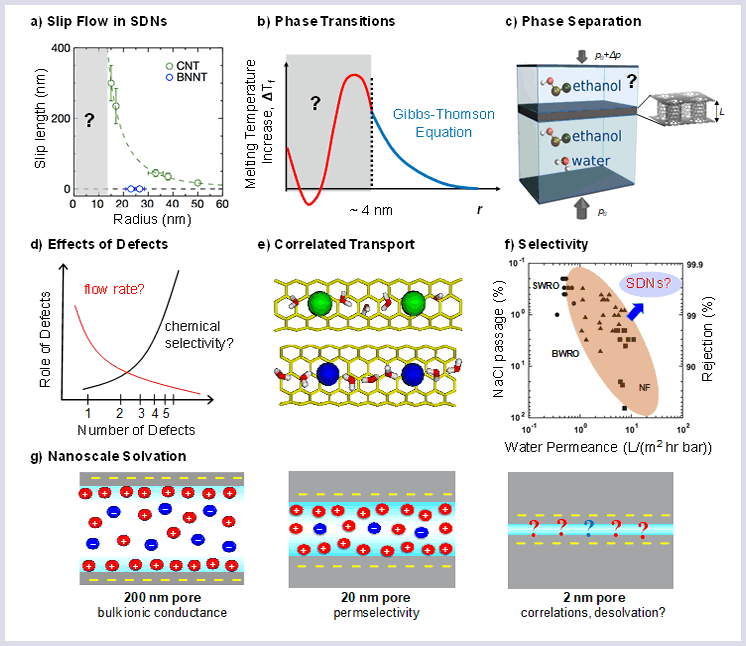Knowledge Gaps
CENT 2
CENT has been addressing a series of fundamental scientific questions, or knowledge gaps (KGs), surrounding the behavior of confined fluids and electrolytes. Since 2022, CENT2 has been addressing 3 distinct KGs surrounding confinement in dynamic and conducting single-digit nanopores (SDNs):
KG1: Transport Across Electrically Conducting Pores
CENT1 has developed fundamental understanding of slip flow enhancement (i.e., substantially higher mass transport rates in smaller nanopores), which now enables us to devise new mechanisms of fluidic enhancement, such as electrically driven boundary flow, involving the coupled transport of fluid in the SDN and electrons in the confining material that forms the nanopore. Our thermodynamic measurements inside SDNs have uncovered fluid phase boundaries that are remarkably distorted from their bulk fluid counterparts, demonstrating the so-called non-Gibbs-Thomson behavior and leading to an inability of existing models to predict the existence of vapor, liquid or solid phases within the narrowest of pores.
KG2: Ion Selectivity In Chemically Patterned Pores
KG2 seeks to use chemically patterned SDNs that are only otherwise found in nature; to manipulate fluid phase boundaries as well as transport behavior at the extreme confinement for fundamentally new separation regimes. We address the key gaps in our understanding of biological ion channels and aim to apply this knowledge to design synthetic channels with ultrahigh selectivities exceeding 1000:1 molecular ratios seen in natural systems. This KG seeks to develop a new design theory and rules for ion-ion selectivity by synthesizing findings from natural channels and simulations on model SDNs. We also aim to identify the constituent ion selectivity mechanisms in chemically patterned SDNs and explore techniques to create precise, spatially organized chemical environments within these systems. Ultimately, the investigation will contribute valuable insights for designing synthetic channels with enhanced ion selectivity for diverse applications.
KG3: Transport Under Temporal Forcing
KG3 examines molecular transport and separations under forced modulation, either electrokinetic (3A) or mechanical (3B), with tunable frequency and amplitude to exert new types of control over transport at the molecular scale.
Electrochemical Modulation (KG3A): KG3A focuses on understanding how ions in SDNs are driven away from equilibrium when exposed to a time-varying electric field, thereby enabling controlled selective transport. The study aims to examine the impact of a time-varying electric field on the modification of the electrical double layer (EDL) screening in SDNs, with specific attention to the role played by pore size and geometry. Furthermore, the research seeks to uncover the relationship between transport, selectivity, and EDL adjustment in the presence of a time-varying electric field, aiming to leverage this understanding for the enhancement of selective ion transport within SDNs.
Mechanical Modulation (KG3B): KG3B aims to explore the mechanistic origins behind strain-dependent ion selectivity, exploring the underlying principles governing this phenomenon. Additionally, the research seeks to assess the feasibility of utilizing these mechanisms to design SDNs with tunable and controllable selectivity, offering insights into the rational engineering of these materials for specific applications. Furthermore, the proposal addresses the potential for leveraging the electronic properties of SDNs as sensitive indicators of strain, exploring their utility for monitoring mechanical changes.

CENT 1
CENT1 addressed 7 distinct KGs surrounding confinement in static, insulating SDNs:
KG1: Slip Flow Enhancement in SDNs is Unexpectedly Enormous
Several recent studies suggest that paradoxically the narrowest pores, indeed SDNs, demonstrate the largest slip length enhancements. Mechanistic understanding of this scaling is in its infancy as theory and simulations have failed to predict recent measurements on larger nanopores. However, SDNs demonstrating this flux enhancement will inspire a new generation of high flux, high selectivity membrane technology. Indeed, one of the key knowledge gaps identified in the 2018 BES Report for Basic Research Needs for Energy and Water states that “a good understanding is lacking of the synergistic effects of confinement and the interactions among water, solutes, and materials through which permeation occurs.”
KG2: Fluid Phase Transitions in SDNs Deviate Significantly from Bulk Fluids
Confined fluids in nanopores exhibit significant distortions of the unconfined phase boundary. These distorted phase transitions are well understood for pores larger than approximately 4 nm through the use of the Turnbull coefficient and the Gibbs Thomson equation. However, no theory currently exists for describing the narrowest of pores represented by SDN. Below approximately 4 nm, the Gibbs Thomson equation fails significantly, with freezing points elevating or depressing dramatically, and varying nonmonotonically with pore diameter.
KG3: Phase-Separation under Confinement for Novel Separation Mechanisms
Phase separation, where a single phase transitions into the two- or multi- phase co-existence region, is also distorted under the extreme confinement of SDNs. Of particular interest is the use of this phenomenon to discover new nanopore and membrane separation mechanisms. Very little is known about the behavior of non-aqueous fluids under similar conditions of extreme nano-confinement, as in SDNs. We anticipate and seek to theoretically describe spontaneous ordering of the solvent, precipitation, and phase separation. A related question is whether and how the confinement in a small nanopore changes the thermodynamics and kinetics of phase separation of ordinarily miscible fluids.
KG4: Defects Impose an Outsized Impact on SDN Transport
The 2018 BES Report for Basic Research Needs for Energy and Water states that “there is a knowledge gap at how physical and chemical heterogeneities affect transport and interfacial interactions.” Unlike the larger pores, where the fluid can easily flow around a defect site, enhanced confinement in SDNs could amplify the effects of a defect or a feature in the structure of the fluid conduit. An intriguing hypothesis is that in extreme cases fluid interactions with defects in SDNs and the resulting pinning effects could completely change the nature of the transport through the pore. Remarkably, except a few recent studies, these effects remain completely unexplored.
KG5: Correlated Transport of Ions can Result from Confinement in SDNs
Strong nanopore confinement, which is often accompanied by partial or complete solute desolvation, can also give rise to interesting physical phenomena where the ions and molecules exhibit unusual spatial and temporal correlation. Partial removal of ion solvation shells, which prevents those ions from forming long-term pairs in the bulk, could lead to unusually long-lived ion pairs and even larger aggregates, and potentially enhanced reaction dynamics. Spontaneous long-scale ordering in nanopores could also create conditions for efficient and selective transport of particular species. Enhancements in the scaling of flux and selectivity for SDNs point to operating regions for nanopore systems (i.e., membranes) that break flux-selectivity tradeoffs.
KG6: SDNs can Exploit Nanoscale Solvation for New Separation Mechanisms
As confinement approaches the levels seen in SDN channels, solvation effects start to diverge from their bulk pattern with profound effects on transport efficiency and selectivity. We need to understand the energetics of solvation under strong confinement and determine how these effects change energy barriers for nanopore entry and the double-layer effects inside the pore. Understanding and exploiting these phenomena in synthetic SDNs could produce a new generation of membranes that are capable of manipulating hydration effects to achieve single-species selectivity in a manner that is virtually impossible to achieve with current technologies.
KG7: SDNs can Exploit Charge Exclusion to Significantly Enhance Selectivity
Membrane-based technologies have been identified in the BES Report for Basic Research Needs for Energy and Water as one of the most important energy-water issues. To date, synthetic, single-species selective membranes (transporting e.g., K+ but not Na+) do not exist. Systematically studying steric- and charge exclusion mechanisms, as well as incorporating interpore chemistry and controlled reaction sites in SDNs will facilitate the improvement of the selectivity of state-of-the-art membrane and provide design principles for new multipore selective systems.

Critical knowledge gaps in SDN nanofluidics. (a) The scaling of slip length with nanopore diameter is unknown in the single-digit range. (b) The phase behavior of fluids inside SDNs cannot be predicted with existing theories. (c) Phase separation may be enhanced by nanoconfinement. (d) Defects may have an outsized effect on transport inside single-digit nanopores, but the magnitude of these effects is unknown. (e) Transport of ions in single-digit nanopores shows novel spatial and temporal correlations. (f) SDNs may form the basis for systems with enhanced molecular and ionic selectivity. (g) Solvation in confinement differs from that in bulk, with profound effects on transport rates and selectivity.
More can be found in our recent paper: “Critical Knowledge Gaps in Mass Transport through Single-Digit Nanopores: A Review and Perspective” by S. Faucher et al. in J. Phys. Chem. C (2019).
